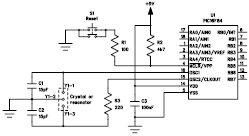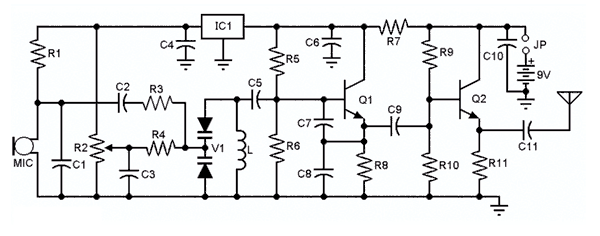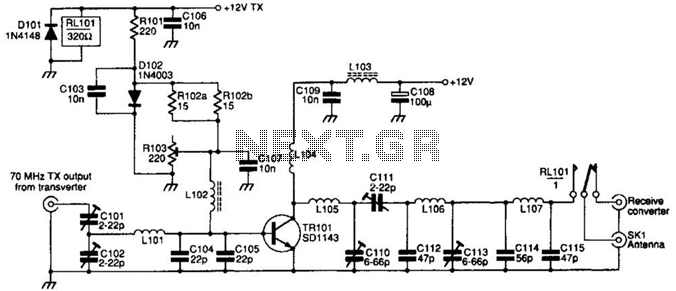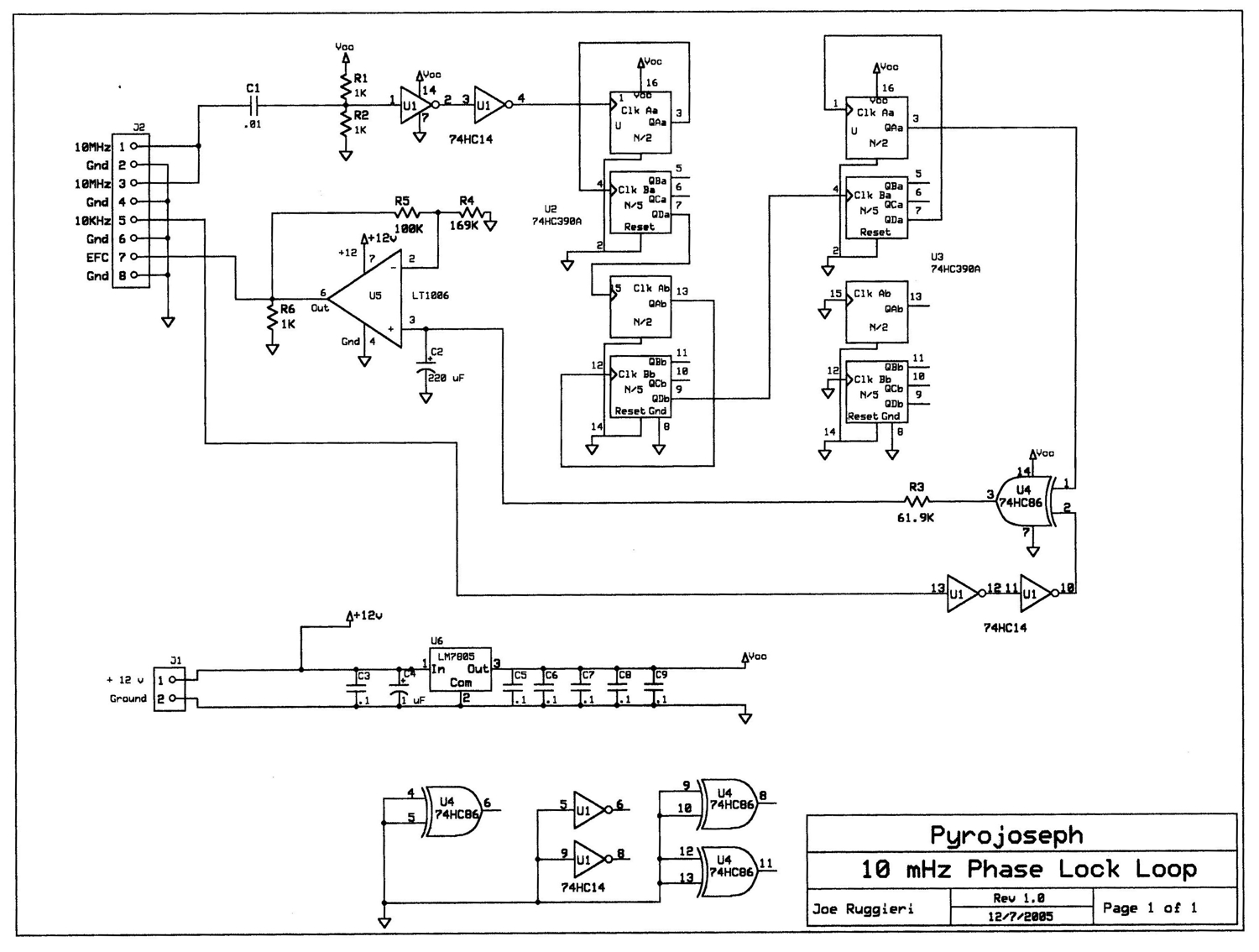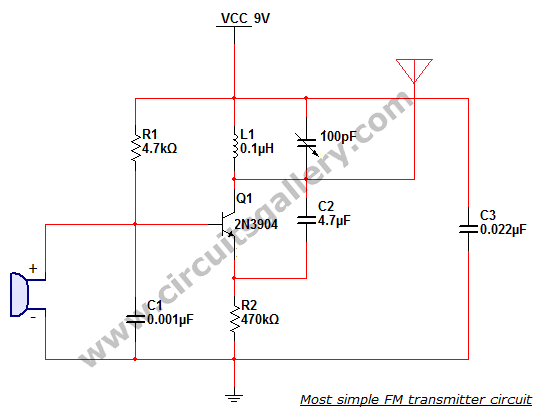
Quality FM-TV micro transmitter 40-200 Mhz
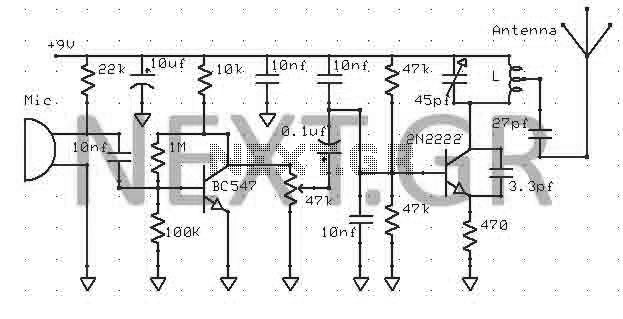
This transmitter can be powered by a 9V battery (not exceeding 12V). Users can connect a music source at the microphone input or utilize a simple condenser microphone. The signal range can reach up to 400 meters in open air. The frequency range is adjustable; it can be tuned to the FM band (88-108 MHz) or the TV band (40-80 MHz). Adjustments can be made using the coil and the variable capacitor to achieve the desired frequency, provided a compatible receiver is available.
The circuit design is straightforward. The first stage consists of a pre-amplifier using a BC547 transistor, followed by the transmitter stage utilizing a 2N2222 transistor. For the antenna, a half-meter wire is recommended, although optimal performance is achieved when the length is proportional to the wavelength. A telescopic antenna may also be employed. For instance, at 90 MHz, the antenna length should be approximately 80 cm; at 95 MHz, around 75 cm; and at 100 MHz, about 70 cm.
The coil (L) is constructed from 0.8 mm diameter wire, wound on a 4 mm diameter form. The number of turns and the spacing between the turns are determined by the selected frequency.
The transmitter circuit operates efficiently within the specified voltage range, ensuring that the BC547 transistor amplifies the audio signal from the connected music source or condenser microphone. The amplified signal is then fed into the 2N2222 transistor, which functions as the oscillator and modulator, converting the audio signal into a radio frequency signal.
The design allows for flexibility in tuning, accommodating different frequencies by adjusting the coil and variable capacitor. The coil's dimensions and the number of turns are critical in determining the resonant frequency, which is essential for effective transmission. The use of a wire antenna or a telescopic antenna enhances the transmission range, with the recommended lengths ensuring optimal performance across the specified frequency bands.
Overall, this transmitter circuit serves as a versatile platform for audio transmission, suitable for various applications while maintaining simplicity and ease of use.This Transmitter can be powered by a battery 9V (not more than 12V). You can connect your music source where the microphone is or use a simple condenser microphone. The range of signal can reach 400 meters in open air. The wide range of frequency is up to you. Tune it at FM band (88-108) or TV band 40-80Mhz. Play with the Coil and the variable capacitor to tune it to any frequency you want as long as you got the receiver. The circuit is as simple as it gets. First stage is the pre-amplifier with BC547 transistor and second comes the transmitter which use the 2N2222 transistor. For antenna use a half meter wire, but for best results the length has to be relative to wave length.
A telescopic antenna can be used also. For example at 90Mhz the length has to be around 80cm, at 95Mhz should be 75cm long, or at 100Mhz should be 70cm and so on. The coil L is a 0.8mm wide wire, formed on a 4mm coil diameter. The number of turns and the air distance between the turns depends on the frequency you want to choose.
The circuit design is straightforward. The first stage consists of a pre-amplifier using a BC547 transistor, followed by the transmitter stage utilizing a 2N2222 transistor. For the antenna, a half-meter wire is recommended, although optimal performance is achieved when the length is proportional to the wavelength. A telescopic antenna may also be employed. For instance, at 90 MHz, the antenna length should be approximately 80 cm; at 95 MHz, around 75 cm; and at 100 MHz, about 70 cm.
The coil (L) is constructed from 0.8 mm diameter wire, wound on a 4 mm diameter form. The number of turns and the spacing between the turns are determined by the selected frequency.
The transmitter circuit operates efficiently within the specified voltage range, ensuring that the BC547 transistor amplifies the audio signal from the connected music source or condenser microphone. The amplified signal is then fed into the 2N2222 transistor, which functions as the oscillator and modulator, converting the audio signal into a radio frequency signal.
The design allows for flexibility in tuning, accommodating different frequencies by adjusting the coil and variable capacitor. The coil's dimensions and the number of turns are critical in determining the resonant frequency, which is essential for effective transmission. The use of a wire antenna or a telescopic antenna enhances the transmission range, with the recommended lengths ensuring optimal performance across the specified frequency bands.
Overall, this transmitter circuit serves as a versatile platform for audio transmission, suitable for various applications while maintaining simplicity and ease of use.This Transmitter can be powered by a battery 9V (not more than 12V). You can connect your music source where the microphone is or use a simple condenser microphone. The range of signal can reach 400 meters in open air. The wide range of frequency is up to you. Tune it at FM band (88-108) or TV band 40-80Mhz. Play with the Coil and the variable capacitor to tune it to any frequency you want as long as you got the receiver. The circuit is as simple as it gets. First stage is the pre-amplifier with BC547 transistor and second comes the transmitter which use the 2N2222 transistor. For antenna use a half meter wire, but for best results the length has to be relative to wave length.
A telescopic antenna can be used also. For example at 90Mhz the length has to be around 80cm, at 95Mhz should be 75cm long, or at 100Mhz should be 70cm and so on. The coil L is a 0.8mm wide wire, formed on a 4mm coil diameter. The number of turns and the air distance between the turns depends on the frequency you want to choose.
